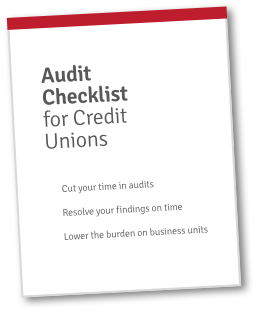In part one of this series, Point West Credit Union was frustrated with their audit program. Extensive, shifting NCUA regulations kept them on their toes. Although they were successfully navigating their audit environment, they worried they spent too much time on their audit process and not enough time on their audit tasks.
Their audit process was murky and confusing, and it was hard to see the details. It was like having bad eyesight without knowing it—they knew things were difficult, but they weren’t aware that they had a solvable problem.
However, as the saying goes, “the first step to solving a problem is admitting you have one.” Point West’s first move was to understand where their problem lay. They came to a startling conclusion.
Excel and Outlook Were Slowing Things Down
Point West Credit Union ultimately concluded that part of what was slowing their audit pace down was Microsoft’s Outlook and Excel. They were too clunky and cumbersome to handle the needs of a robust NCUA audit program.It’s ironic, but productivity software was hindering Point West’s productivity. Here’s how:
Where Outlook Fell Short
Outlook is a great generic calendar and email tool. It’s flexible enough to handle most business needs with ease. For most intents and purposes, there are no issues with Outlook in a credit union setting.However, Outlook’s weakness is that it’s generic. By trying to work for so many purposes, it compromises utility in specialized circumstances. By using outlook, Point West’s audit team had to deal with a couple major issues.
First, by conducting external audit communications over email, Point West opened their entire exchange server to legal discovery. While that wasn’t an issue, it does introduce significant risk. No credit union wants to give their external auditors the opportunity to increase their scope of inquiry or drag the process on even longer than usual.
Second, it was easy to lose track of items, changes, and other critical information over email. Their process involved a lot of email communication and documents shared over their exchange. Attaching files, tracking changes, and maintaining version control was difficult without a central, official location to manage their audit documents.
Where Excel Fell Short
“[Excel] was a great way to aggregate some of the data, but the problem was that when you take all that information and try to have multiple people working on it together—responses to any audit findings, changing target dates—none of that was captured,” said Steve Pagenstecher, VP of Member Services at Point West Credit Union. “And then, it was all done manually. So, anytime something changed, there wasn’t an audit trail of who made the change and why.”Pagenstecher was right. Although Outlook wasn’t optimal, it worked. Excel, on the other hand, was Point West’s biggest bugbear. Issues stemming from Excel were robbing Point West’s team of hours of productive time.
To start with, it requires a lot of manual input, which is time-consuming, and tedious—two factors that increase the risk of human error. More significantly, Point West noted that as documents were shared, multiple versions of those documents started floating around. This led to version control issues that required lengthy follow-up communications with the team to resolve them.
Another issue was that there’s no audit trail when using Excel. Point West’s audit team didn’t always know:
- If something had changed
- What exactly had been changed
- Who made the change
- Why the change was made
- When the change was made
Sometimes, an item that was previously marked as completed would suddenly appear incomplete. Issues like that took extensive communication and coordination to resolve, which complicated the audit process even further.
The Effect of Using Sub-Optimal Credit Union Compliance Software
The major problem is that Excel and Outlook are not credit union compliance software. They’re productivity tools that are frequently co-opted for audit purposes, but they’re not designed with audits in mind.Point West Credit Union was seeing the results of sub-optimal compliance software on their audit process. Throughout the course of an audit, it became “really hard for us to aggregate all that data in a meaningful way, and then report back out to the supervisory committee, to the board, and even to our own team,” Pagenstecher said. “And it’s because we were sending around multiple emails with multiple Excel files trying to address all of the findings at once.”
Essentially, Pagenstecher’s team was hindered by using several applications to complete one job. It led to miscommunications, lost items, stressful deadlines, repeat findings, and version control issues. They wanted a secure, central hub with which to manage their audit process.
What Point West Credit Union Wanted in an Audit Management Software Suite
Point West found that they were wasting countless hours managing their audit process instead of addressing their audit tasks. They had no reliable way of keeping track of all their audit needs, the most important of which included:- Who was working on which items
- When each item was due
- What was in progress
- Which items still needed to be addressed
Instead of spending the bulk of their time coordinating, communicating, compiling, double-checking items, as well as building an audit trail, Point West hoped they could stay on top of all that in one seamless platform.
They already knew how to deliver a great audit—they just wanted an easier way to do it.

FREE: Audit Checklist for Credit Unions
4 key principles and 9 questions to jumpstart your audit planning. From leading credit unions.Identifying the Problem Was the Hard Part—Solving It Was Easy
Once Pagenstecher and Point West realized how much time Outlook and Excel took, they looked for better ways to manage their audit process.Their solution would need to offer a centralized hub where they could access all necessary audit documents and communication. The hub would have to keep track of important tasks, people, dates, and changes. It would need to be secure. Finally, it would have to be easy to use—they didn’t want to lose even more time while learning how to use a complicated software suite.
After a little digging, they discovered Redboard’s external audit management and credit union compliance software.
In Part 3 of this series, Point West optimized their audit process by using Redboard’s simple software.
In case you missed it, you can also read Part 1 of the case study here.
If you like, you can download the entire Point West case study here.
Other related blogs can be found here:
The Hidden Risks in Credit Union Regulatory Examinations — and How to Avoid Them
5 Strategies to Avoid Risk During Your Credit Union’s Next Regulatory Examination






